What is wind?
Wind is air in motion. It is produced by the uneven heating of the earth’s surface by the sun. Since the earth’s surface is made of various land and water formations, it absorbs the sun’s radiation unevenly. Two factors are necessary to specify wind: speed and direction.
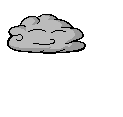
What causes the wind to blow?
As the sun warms the Earth's surface, the atmosphere warms too. Some parts of the Earth receive direct rays from the sun all year and are always warm. Other places receive indirect rays, so the climate is colder. Warm air, which weighs less than cold air, rises. Then cool air moves in and replaces the rising warm air. This movement of air is what makes the wind blow.
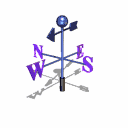
What is a windstorm?
A windstorm is just a storm with high winds or violent gusts but little or no rain.
What is a gust front?
A gust front is the leading edge of cool air rushing down and out from a thunderstorm. There are two main reasons why the air flows out of some thunderstorms so rapidly. The primary reason is the presence of relatively dry air in the lower atmosphere. This dry air causes some of the rain falling through it to evaporate, which cools the air. Since cool air sinks (just as warm air rises), this causes a down-rush of air that spreads out at the ground. The edge of this rapidly spreading cool pool of air is the gust front. The second reason is that the falling precipitation produces a drag on the air, forcing it downward. If the wind following the gust front is intense and damaging, the windstorm is known as a downburst.
What is a downburst?
A downburst is created by an area of significantly rain-cooled air that, after hitting ground level, spreads out in all directions producing strong winds. Unlike winds in a tornado, winds in a downburst are directed outwards from the point where it hits land or water. Dry downbursts are associated with thunderstorms with very little rain, while wet downbursts are created by thunderstorms with high amounts of rainfall.
What is a derecho?
A derecho is a widespread and long-lived windstorm that is associated with a fast-moving band of severe thunderstorms. They can produce significant damage to property and pose a serious threat life, primarily by downburst winds. To be classified as a derecho, the path length of the storm has to be at least 280 miles long. Widths may vary from 50-300 miles. Derechos are usually not associated with a cold front, but a stationary front. They occur mostly in July, but can occur at anytime during the spring and summer.
What is the jet stream?
The jet stream is a fast flowing, river of air found in the atmosphere at around 12 km above the surface of the Earth just under the tropopause. They form at the boundaries of adjacent air masses with significant differences in temperature, such as of the polar region and the warmer air to the south. Because of the effect of the Earth's rotation the streams flow west to east, propagating in a serpentine or wave-like manner at lower speeds than that of the actual wind within the flow.
What is a monsoon?
A monsoon is a seasonal wind, found especially in Asia that reverses direction between summer and winter and often brings heavy rains. In the summer, a high pressure area lies over the Indian Ocean while a low exists over the Asian continent. The air masses move from the high pressure over the ocean to the low over the continent, bringing moisture-laden air to south Asia. During winter, the process is reversed and a low sits over the Indian Ocean while a high lies over the Tibetan plateau so air flows down the Himalaya and south to the ocean. The migration of trade winds and westerlies also contributes to the monsoons. Smaller monsoons take place in equatorial Africa, northern Australia, and, to a lesser extent, in the southwestern United States.
What are the Santa Ana Winds?
The Santa Ana winds are strong, extremely dry down-slope winds that originate inland and affect coastal Southern California and northern Baja California. Santa Ana winds blow mostly in autumn and winter, but can arise at other times of the year. They can range from hot to cold, depending on the prevailing temperatures in the source regions, the Great Basin and upper Mojave Desert. The winds are known especially for the hot dry weather (often the hottest of the year) that they bring in the fall, and are infamous for fanning regional wildfires. For these reasons, they are sometimes known as the "devil winds" across Southern California.
What are the global wind patterns?
The equator receives the Sun's direct rays. Here, air is heated and rises, leaving low pressure areas behind. Moving to about thirty degrees north and south of the equator, the warm air from the equator begins to cool and sink. Between thirty degrees latitude and the equator, most of the cooling sinking air moves back to the equator. The rest of the air flows toward the poles.
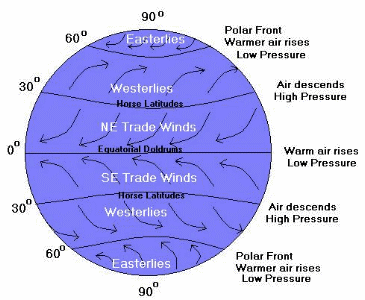
What are the trade winds?
The trade winds are just air movements toward the equator. They are warm, steady breezes that blow almost continuously. The Coriolis Effect makes the trade winds appear to be curving to the west, whether they are traveling to the equator from the south or north.
What are the doldrums?
The doldrums is an area of calm weather. The trade winds coming from the south and the north meet near the equator. These converging trade winds produce general upward winds as they are heated, so there are no steady surface winds.
What are the prevailing westerlies?
Between thirty and sixty degrees latitude, the winds that move toward the poles appear to curve to the east. Because winds are named from the direction in which they originate, these winds are called prevailing westerlies. Prevailing westerlies in the Northern Hemisphere are responsible for many of the weather movements across the United States and Canada.
What are the polar easterlies?
At about sixty degrees latitude in both hemispheres, the prevailing westerlies join with the polar easterlies to reduce upward motion. The polar easterlies form when the atmosphere over the poles cools. This cool air then sinks and spreads over the surface. As the air flows away from the poles, it is turned to the west by the Coriolis effect. Again, because these winds begin in the east, they are called easterlies.
What is a sea breeze?
On a warm summer day along the coast, this differential heating of land and sea leads to the development of local winds called sea breezes. As air above the land surface is heated by radiation from the Sun, it expands and begins to rise, being lighter than the surrounding air. To replace the rising air, cooler air is drawn in from above the surface of the sea. This is the sea breeze, and can offer a pleasant cooling influence on hot summer afternoons.
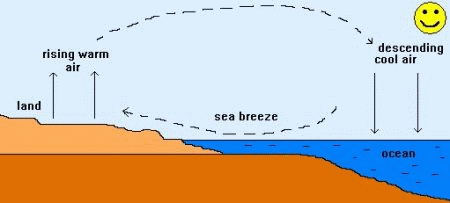
What is a land breeze?
A land breeze occurs at night when the land cools faster than the sea. In this case, it is air above the warmer surface water that is heated and rises, pulling in air from the cooler land surface.
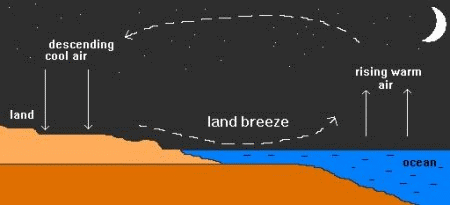
How is wind helpful to Earth?
Wind is the fastest growing source of electricity in the world. It's often one of the least expensive forms of renewable power available. Some experts say it can sometimes be the cheapest form of any kind of power. Generating power from the wind leaves no dangerous waste products behind. Best of all, its supply is unlimited.
How do windmills work?
Windmills work because they slow down the speed of the wind. The wind flows over the airfoil shaped blades causing lift, like the effect on airplane wings, causing them to turn. The blades are connected to a drive shaft that turns an electric generator to produce electricity.
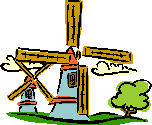
What are some different types of wind names?
Many local wind systems have their own names. Here's a few!
chinook-(westerly wind off the eastern side of the Rocky Mountains)
santa ana-(easterly towards Southern California )
scirocco-(southerly from North Africa to southern Europe)
mistral-(northwesterly from central France to Mediterranean)
marin-(southeasterly from Mediterranean to France)
bora-(northeasterly from eastern Europe to Italy)
gregale-(northeasterly from Greece)
etesian-(northwesterly from Greece)
libeccio-(southwesterly towards Italy)
 Beaufort
Scale
Beaufort
Scale
The Beaufort scale is an empirical measure for the intensity of the weather based mainly on wind power. The scale was created by the British naval commander Sir Francis Beaufort around 1806.
| Beaufort number | Wind
speed MPH |
Wind
Speed Knots |
Description | Sea conditions | Land conditions |
| 0 | <1 | <1 | Calm | Flat | Calm |
| 1 | 1-3 | 1-3 | Light air | Ripples without crests | Wind motion visible in smoke |
| 2 | 4-7 | 4-6 | Light breeze | Small wavelets | Leaves rustle |
| 3 | 8-12 | 7-10 | Gentle breeze | Large wavelets | Smaller twigs in constant motion |
| 4 | 13-18 | 11-16 | Moderate breeze | Small waves | Small branches begin to move |
| 5 | 19-24 | 17-21 | Fresh breeze | Moderate longer waves | Smaller trees sway |
| 6 | 25-31 | 22-27 | Strong breeze | Large waves with foam crests | Large branches in motion |
| 7 | 32-38 | 28-33 | Near gale | Sea heaps up and foam begins to streak | Whole trees in motion |
| 8 | 39-46 | 34-40 | Gale | Moderately high waves with breaking crests | Twigs broken from trees |
| 9 | 47-54 | 41-47 | Severe gale | High waves with dense foam | Light structure damage |
| 10 | 55-63 | 48-55 | Storm | Very high waves. The sea surface is white |
Trees uprooted. Considerable structural damage |
| 11 | 64-72 | 56-63 | Violent storm | Exceptionally high waves | Widespread structural damage |
| 12 | 73-82 | 64-71 | Hurricane | Sea completely white with driving spray. | Massive and widespread damage to structure |
 Wind Activities
Wind Activities
Lesson Plan: Here is a great activity the shows students how the winds work across the globe.
Wind Experiment: Here is a great experiment that allows the kids to find out what's in the wind. The kids will be very surprised at what they see!
Anemometer Experiment: Here is another great experiment that lets kids make an anemometer or wind vane.
Pinwheel Experiment: Here is an experiment that allows the kids to make a pinwheel to see how wind is created.
Windsock Experiment: Here is an experiment that allows the kids to make a windsock.
Pressure Experiment: Here is an experiment that shows how pressure is created in our atmosphere by sucking an egg in a bottle. This is a very cool experiment!
Make A Barometer Experiment: Here is an experiment that allows the kids to make a barometer.
Evaporation Experiment: Here is an experiment that shows kids how evaporation takes place.
Science Fair Project Ideas: Here is a complete list of science fair project ideas. Discover the science behind the weather that impacts us every day.